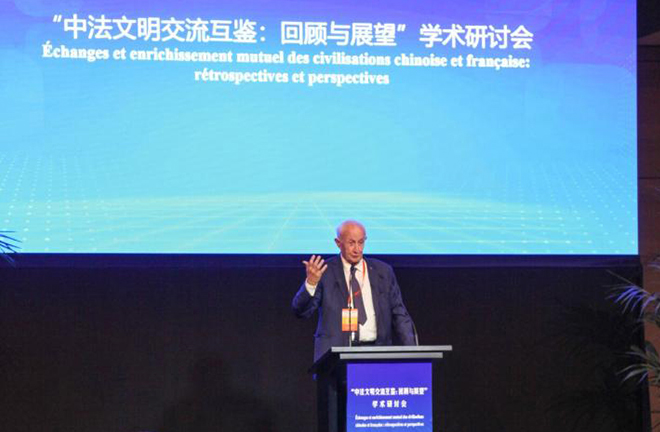Henry de Lumley: Pioneer of China-France joint archaeology

Henry de Lumley Photo: BUREAU OF INTERNATIONAL COOPERATION at CASS
Henry de Lumley is director of the Institute of Human Paleontology in Paris, a corresponding member of the French Academy of Sciences and the French Academy of Inscriptions and Letters, and a professor emeritus and former director of the French National Museum of Natural History. At a seminar titled “Exchanges and Mutual Learning between Chinese and French Civilizations” on May 3, 2024, Professor Lumley, at a spry 90 years of age, and brimming with pride and a sense of achievement, affectionately reviewed the 110-year history of Chinese-French cooperation in Paleolithic archaeology, as well as his nearly-50-year experience of exchanging with his Chinese counterparts.
China-France joint archaeological endeavors boast a solid foundation of collaboration. As early as in 1914, French naturalist, geologist, paleontologist, and archaeologist Emile Licent discovered the fossilized tooth of “Hetao Man,” the earliest-known human fossil found in China, alongside the first chipped stone tool, marking the beginning of his journey of Paleolithic archaeology in China. Subsequently, French archaeologists Pierre Teilhard de Chardin and Abbe Henri Breuil also came to China and participated in the excavation and research of the Peking Man Site at Zhoukoudian in suburban Beijing. They joined forces with a number of pioneering Chinese Paleolithic archaeologists, including Pei Wenzhong, Jia Lanpo, and Hu Chengzhi, together building a bridge for later China-France cooperation. In his speech, Professor Lumley reminisced that since 1980, he has cooperated with Chinese peers such as Li Yanxian and Gao Xing, fostering profound friendships with generations of Chinese archaeologists. Since then, Professor Lumley has visited China for research purposes almost annually, traversing the vast expanse of Chinese territory. “This is a privilege envied even by French ambassadors to China,” he said.
The Lumleys have been staunch advocates for fostering joint archaeology between China and France. Fellow Lumley-Woodyear, Professor Lumley’s wife and a respected French paleoanthropologist, joined the cause of China-France joint archaeology in the late 1970s, actively participating in visits to all hominid sites in China. Additionally, Professor Lumley extended invitations to Chinese archaeologists to visit France for academic exchanges and mentored numerous Chinese students pursuing doctoral degrees in French Paleolithic archaeology. Many of these scholars now serve as professors of archaeology in China, constituting the backbone of China-France joint archaeology.
In his speech, Professor Lumley also looked back at the course of China-France joint archaeology over the past nearly 50 years. He emphasized that Paleolithic archaeology is a multidisciplinary field, involving collaboration among archaeologists, zoologists, and botanists from both countries. Chinese scholars demonstrated exceptional professionalism, with many serving as visiting fellows at research institutes such as the French National Museum of Natural History, studying French hominid sites together with French experts. With joint efforts, Chinese and French scholars have conducted rather complete research on the natural environment, instruments of production, and material remains of hominid sites, systematically showcasing the historical value of the cultural relics and sites.
In 2004, Professor Lumley and his Chinese partners jointly staged an exhibition on ancient Chinese humans at the Musée de l’Homme in Paris. The exhibition showcased all Chinese hominin fossils, including those of the Peking Man and related relics, eliciting enthusiastic responses from the French. Thereafter, he published two French monographs together with Chinese scholars in 2017 and 2020, respectively, on the Yunxian Man Site in central China’s Hubei Province, and the Paleolithic site in the Bose Basin in Guangxi Zhuang Autonomous Region. Despite his advanced age, Professor Lumley remains deeply passionate about China-France joint archaeology. In early 2024, he revisited Hubei and signed an agreement with his Chinese counterparts on joint research on early Paleolithic stonework discovered on the high terraces of the Hanjiang River. His future plans include collaboratively publishing works in both Chinese and French to introduce this discovery and the latest research outcomes to the world.
Edited by YANG LANLAN
